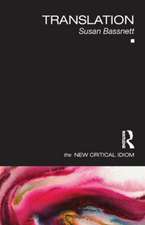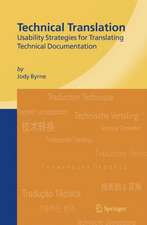Method in Translation History
Autor Anthony Pymen Limba Engleză Paperback – 1998
| Toate formatele și edițiile | Preț | Express |
|---|---|---|
| Paperback (1) | 370.46 lei 6-8 săpt. | |
| Taylor & Francis – 1998 | 370.46 lei 6-8 săpt. | |
| Hardback (1) | 1001.07 lei 6-8 săpt. | |
| Taylor & Francis – feb 2016 | 1001.07 lei 6-8 săpt. |
Preț: 370.46 lei
Nou
70.89€ • 74.22$ • 58.80£
Carte tipărită la comandă
Livrare economică 10-24 aprilie
Specificații
ISBN-10: 1900650126
Pagini: 234
Ilustrații: illustrations
Dimensiuni: 156 x 234 x 15 mm
Greutate: 0.47 kg
Ediția:1
Editura: Taylor & Francis
Colecția Routledge
Locul publicării:Oxford, United Kingdom
Public țintă
PostgraduateCuprins
Preface
Acknowledgements
1. History
History within translation studies
The parts of translation history
The interdependence and separateness of the parts
A too-brief history of translation history
Reasons for doing translation history
2. Importance
What is importance?
5Against blithe empiricism
Personal interests
Research and client interests
Subjective interests and humility
3. Lists
Reasons for lists
Getting data
The difference between catalogues and corpora
Shortcomings in bibliographies: four examples
Completeness in history and geology
Sources as shifting sands
The historian as reader of indexes
4. Working definitions
Why some information has to be thrown out
In defence of definitions
Inclusive definitions
Defining translations from paratexts
Corpora of limit cases
How Wagner sneaked in
How Salomé danced out
5. Frequencies
Statistics and importance
Diachronic distribution
Retranslations, reeditions and non-translations
Retranslation and its reasons
A general diachronic hypothesis
6. Networks
Reconstructing networks from within
Mapping networks
Two cheap transfer maps
Lines and symbols
The spatial axis
Cities as borders
7. Norms and systems
Actually reading translations
Norms?
Systems?
Leaps of faith
The will to system
Subjectless prose
Where's the gold?
8. Regimes
What are regimes?
Starting from debates
A regime for twelfth-century Toledo
A regime for Castilian protohumanism
A regime for early twentieth-century poetry anthologies
Translation as a transaction cost
9. Causes
Systemic and probabilistic causation
Aristotle
Transfer as material causation
Final causes in theories of systems and actions
Equivalence as formal cause
Translators as efficient cause
Multiple causation
10. Translators
Translators, not 'the translator'
Translators can do more than translate
Translators have personal interests
Translators can move
Translators can go by several names
11. Intercultures
Where intercultures are hidden
Translations or translators?
Strangers and trust
Interculturality and its negation
Intercultural professions as a social context
An alternative basic link
What is a culture?
12. Interdisciplinarity
Personal reasons for pessimism
A lacking discipline
Cultural Studies
Intercultural Studies
References
Index
Recenzii
... an invaluable contribution to the discipline, long overdue (Zuzan Jettmarova, Across Languages and Cultures)
... asks many fundamental questions about the present state and future direction of translation theory in addition to being an excellent primmer for research students in translation history. (Michael Cronin, Target)
Descriere
This text aims to show that the history of translation need not be an obscure subdiscipline. If studied, it can trace the past of suppressed intermediaries whose work might change our ideas of what cultures are, of what kind of future we can expect from globalization. The author sets about undoing many of the dominant models of translation history, positing that the object of this history should be translators as people, that researchers are subjectively involved in their object, that cultural systems are based on social will, that translators work in intercultural spaces, and that a model of co-operation through negotiation may be applied to the way translators work between cultures. The proposed methodology is constructive, showing how many empirical techniques can be developed and applied. Finding its focus in historical debates, this text should help create contemporary debate.
















